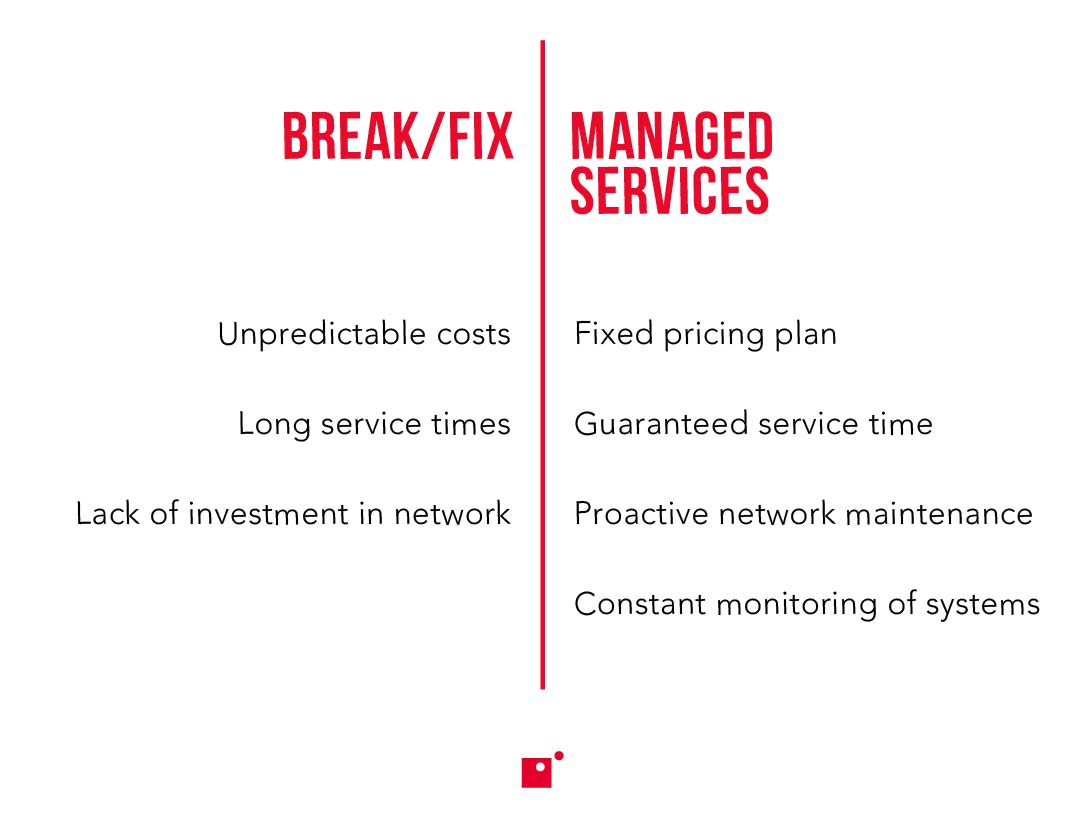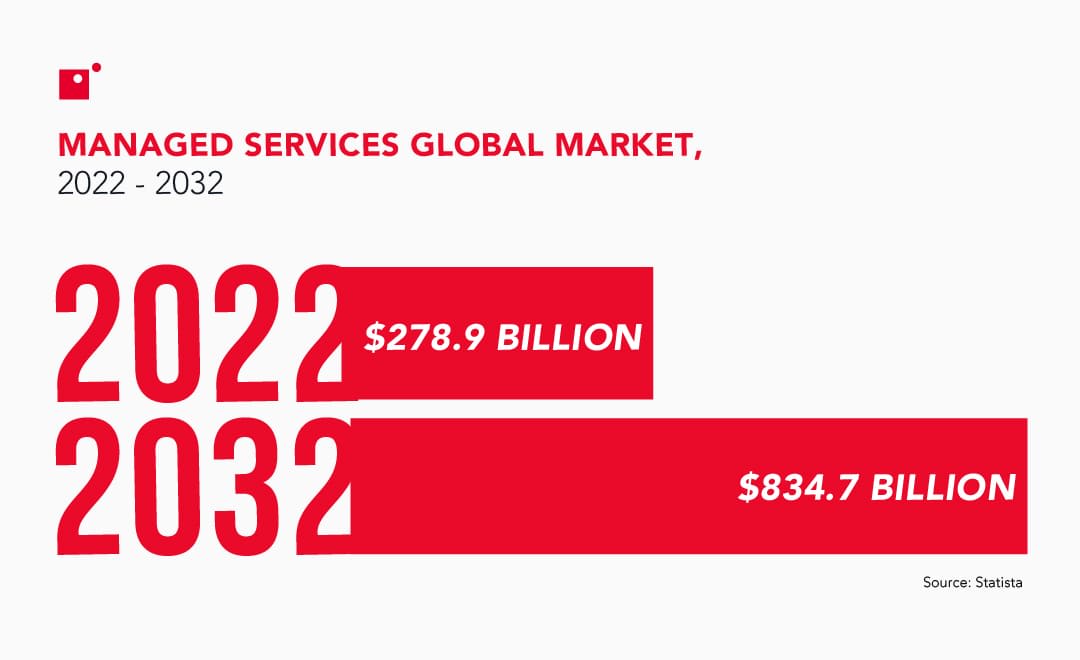In today’s economy, most organizations outsource at least one, if not several, of their operations departments. Whether that’s their IT team, cybersecurity strategy, marketing, or anything else, it’s rare for companies to develop all these different departments internally.
One of the benefits of relying on strategic partnerships for fundamental services is that it allows you, as the business owner, to focus on the meat and potatoes of your service or product offerings while your partners keep those operations running smoothly.
That said, it used to be common for strategic partners to operate with a break/fix model, meaning organizations would only be serviced and billed if something went wrong. This model is quickly being phased out, though, as both strategic partners and the businesses they serve find an ongoing service model much more beneficial.
What you need for your growing business isn’t always clear. Put yourself in a position to make an informed decision by downloading Impact’s eBook, Does Your Business Need a Managed IT Services Provider?
What Is the Break/Fix Service Model?
A break/fix service model refers to IT services provided and billed on an as-needed basis, as opposed to paying a fixed monthly fee for an ongoing service. For instance, if your business uses a break/fix service, the IT company will come and deal with an IT issue, then bill you the applicable amount.
The break/fix model is on the decline, however, as an increasing number of businesses and strategic partners lean into an ongoing service model.
Digital transformation is also continuing to reshape the way businesses manage cybersecurity, IT, technology, and even culture.
Why Is the Break/Fix Model on the Decline?
The frequency at which new technologies emerge continues to disrupt the break/fix operating model, as more organizations opt to partner with a managed services provider (MSP) that operates with an ongoing services model.
This is apparent in the market growth experienced by MSPs (managed service providers). The global MSP market size is expected by some researches to surpass $830 billion by 2032.
Many businesses simply don’t have or don’t want to spend the resources to keep up with new technologies while maintaining and upgrading their on-premise networks and systems. By instead establishing a strategic partnership with a managed IT services provider, organizations have this burden taken off their shoulders and can focus on the core of the business.
Break/Fix vs. Managed Ongoing Services: What are the Differences?
Break/fix is a primarily reactive approach to maintaining IT infrastructure.
Break/fix is a primarily reactive approach to maintaining IT infrastructure or other services. The client organization only engages with external engineers when a piece of hardware fails, or when in-house IT professionals cannot locate the root of a problem within their system.
Once the outsourced engineer fixes the issue, the company receives a bill for their services. This as-needed approach to managing IT systems requires no monthly agreement and usually no ongoing expenses.
“89% of companies expect to grow or maintain their IT budgets this year.”
Conversely, MSPs are proactive and take a prominent role in managing all of an organization’s network with a predictable monthly cost that isn’t influenced by how many tickets arise.
Defining Predictable Pricing
Predictable pricing models for managed IT services are a game-changer for businesses seeking stability and transparency in their IT budgets. Unlike traditional IT support, where costs can fluctuate unpredictably due to hourly charges or unforeseen emergencies, predictable pricing offers a known recurring fee for the duration of the contract.
This model typically covers a comprehensive range of services, such as monitoring, maintenance, security updates, and user support, providing businesses with peace of mind and clear expectations about their IT expenses.
These models are often structured as tiered plans or customized packages, aligning the scope of services with the specific needs of the business. For example, a basic plan might include essential monitoring and troubleshooting, while premium tiers could encompass advanced cybersecurity measures, cloud management, and strategic IT consulting.
This approach allows businesses to scale their IT investments in line with their growth, all while avoiding surprise charges. By offering financial clarity and tailored solutions, predictable pricing models empower businesses to plan confidently and focus on their core operations without IT disruptions derailing their budgets.
Issues With the Break/Fix Model
While older generation IT systems were less complex, in-house teams still needed specialists to configure networks, monitor security, and ensure application uptime.
This made break/fix models of operation a popular service method for smaller operations. You could get whatever you needed and then fix the occasional issues whenever they arise.
With networks becoming increasingly complex and the protection of data more important than ever, however, this touch-and-go approach became less effective and businesses wanted to see more from their strategic partners.
All-in-all, creating the perfect environment for the rise of the ongoing service model.
Low Cost-Efficiency
With a break/fix service model, companies have no real control over their IT budget.
Although this approach may seem cost-effective at first, calling an IT contractor whenever an issue requiring a lot of work arises can be very expensive. Think of it like not having any insurance: It’s great when the sun is shining, but when things go wrong, the cost adds up very quickly.
The department has to make sacrifices, and upgrade cycles are prone to stagnate if issues take longer to resolve. Break/fix service companies also have an incentive to take longer to fix a problem and drive up the number of hours worked on the account, as it becomes the primary revenue source.
As they handle every issue on a case-by-case basis, the callout fees are the only consistent expense the organization knows about upfront, and everything else only becomes clear only after receiving the final invoice.
Lack of Incentive to Optimize IT Infrastructure
Similarly, the break/fix model doesn’t incentivize service providers to invest in the company’s networks or digital infrastructure.
SMBs are spending nearly 1/10th of their IT budgets on server technology. An MSP will help you achieve your upgrades by guiding your strategy depending on your infrastructure needs.
The company’s biggest network losses are the service provider’s biggest gains, so there’s no reason for a break/fix provider to get involved with the future development of the business’ operations. If a break/fix organization could give you infrastructure that lasted forever and didn’t break, they would be putting themselves out of business.
If we consider the break/fix model vs. managed IT services, the MSP works continuously to ensure your network is optimized and outages are minimized.
The break/fix model doesn’t provide companies with access to best-in-class solutions, nor the business development experts who can make recommendations on how to take the organization forward.
Uncertain Service Times
Finally, break/fix vendors provide no certainty about response and repair times. If engineers are already dealing with a client and there’s no one available, you’re out of luck.
Due to the uncertain nature of break/fix services, it’s difficult for providers to guarantee service times for their customers.
For companies that rely on their underlying digital infrastructure to maintain operations, this poses a major risk to both reputation and revenue, particularly in serious cases.
If a major IT issue were to arise, like an outage or even a cybersecurity breach, a business needs assurances that it can be dealt with in an acceptable timeframe.
Benefits of the Managed Services Approach
What’s clear is that the break/fix model is no longer fit for purpose in a modern business environment.
The MSP model has enjoyed enormous success in recent years because it has allowed businesses to partner with providers who have an active interest in taking a proactive approach to their IT and its future.
Below, see a video on how Impact’s managed IT services helped a local business achieve their goals.
Fixed Costs and a Clear SLA
The costs associated with implementing an IT system from the ground up remain expensive. Apart from the infrastructure costs, there’s also the installation, training, and operational management overheads.
By writing the contract with a predictable monthly cost, though, businesses have a better understanding of what their monthly expenses will be, eliminating the guess-work and allowing them to budget accordingly. The SLA (service-level agreement) will outline all accountabilities and responsibilities, so each side understands the other’s expectations.
This applies to other areas, too, so there are no surprises and the client ultimately regains total control over their IT expenses, making budgeting consistent and predictable.
Proactive Network Maintenance and Monitoring
The predictable cost in a contracted partnership with an MSP will often provide automated 24/7 network monitoring. This means that issues are often flagged and resolved by IT experts before the client is aware anything happened.
When it comes to managed IT services vs. the reactive break/fix model, the MSP will almost always resolve issues before they become a large-scale operational problem. Additionally, MSPs will ensure the stability of your IT systems after responding to an incident as labor is factored into the predictable monthly cost.
This means that, unlike break/fix services, it’s fundamentally in an MSPs interest to do everything they can to make sure your IT network runs smoothly.
A Partner Who Is Aligned with Your Business Objectives
MSPs become partners in the long-term process of implementing, maintaining, and upgrading your network systems and digital infrastructure.
They work with customers and their own digital transformation experts to establish an effective digital transformation strategy and align their goals with the operations of the company.
A quality MSP will determine the best modern solutions for businesses.
They act as an expert consultant and provide guidance for where opportunities exist that might not be spotted by the client.
For example, they may notice your organization has many manual repetitive processes. The MSP may recommend implementing a robotic process automation (RPA) software bot to automate these tasks. Or they may point you in the direction of low-code development if your business needs a custom app.
Ultimately, the business gets peace of mind. Risks associated with major concerns like cybersecurity, compliance, and workplace efficiency are mitigated by having a partner who wants to help and has the knowledge and tools to do so.
Clients Can Request Help as Frequently as Needed
Traditional IT teams can struggle to support their systems, especially if there’s a flood of tickets into the incident management solution. With an MSP, the service management team will process all the tickets, leaving the onsite team to deal with their day-to-day tasks.
The MSP will have a dedicated team of IT professionals to quickly assess and escalate issues when necessary, and in most cases, they can deploy corrective actions remotely.
Ultimately, an MSP will reduce pressure on the in-house teams, freeing them up to focus on more strategic initiatives for business operations, rather than their IT infrastructure.
Wrapping Up on the Extinction of Break/Fix Models
- Break/fix is a legacy model: The old way of doing things doesn’t serve company goals for digital transformation. Managing everything in-house simply isn’t feasible for many businesses.
- Managed services support business goals: As more companies move to the cloud and adopt a digital transformation strategy, a team of experts on hand can guide the implementation of new technologies.
- MSPs have your best interests at heart: MSPs work with organizations to manage networks and improve business functions to further a company’s strategic goals.
- The predictable cost model allows for: unlimited tickets and IT maintenance.
- The predictable cost model allows for: easier budgeting and predetermined IT expenses.
Learn more about the managed IT service model and see whether it's right for your organization in Impact's eBook, Does Your Business Need a Managed IT Service Provider?




